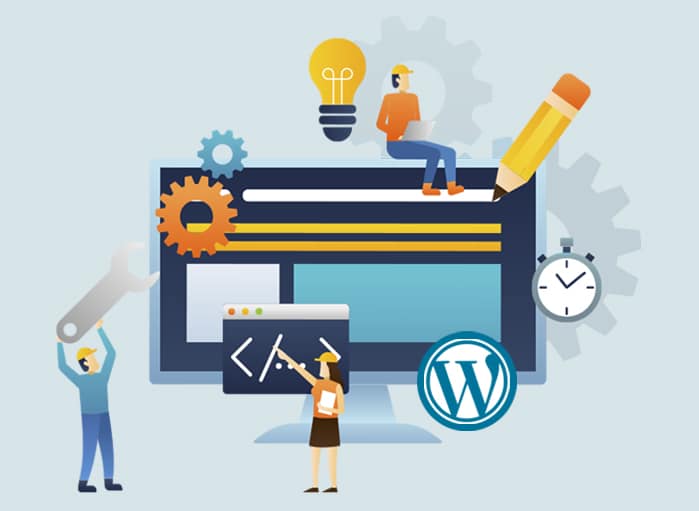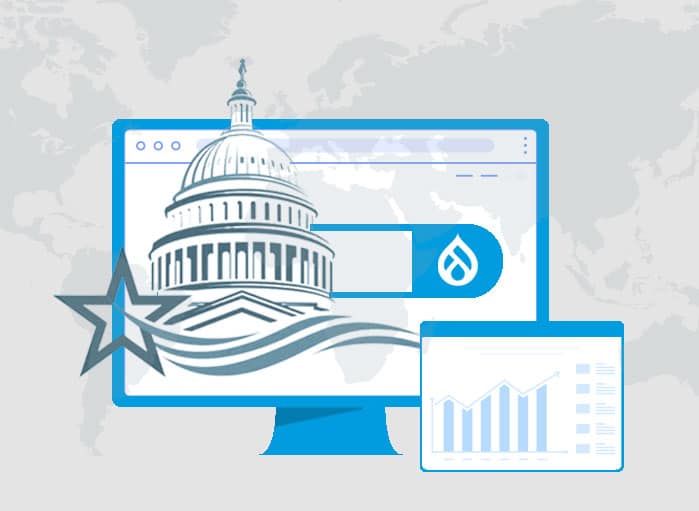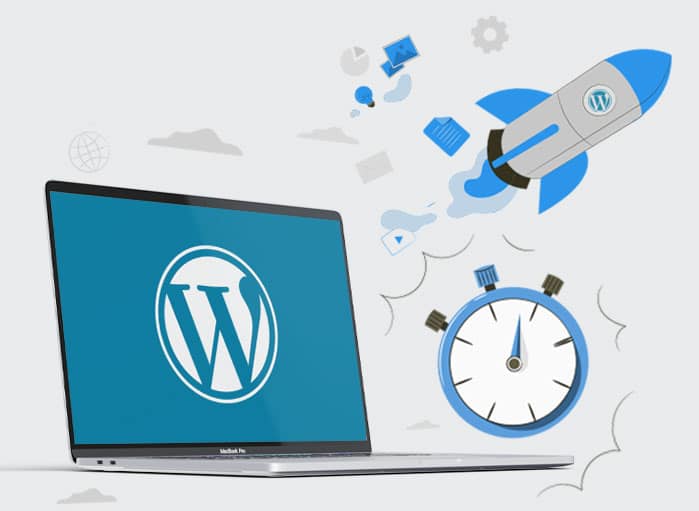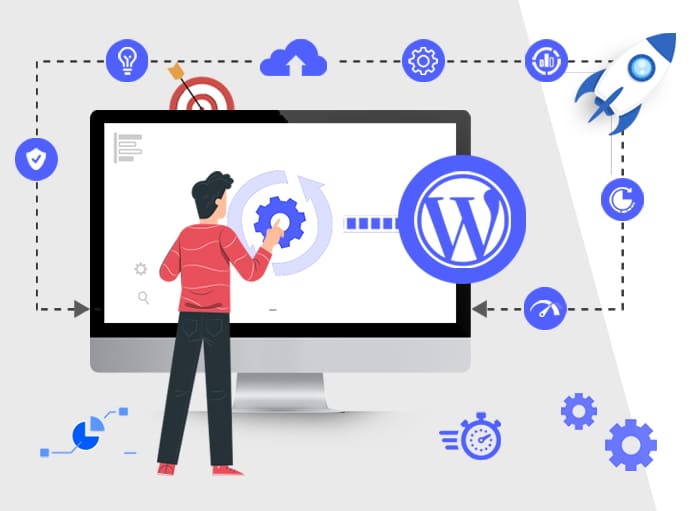Today, when you search for something on the internet, you will get to see around 2 billion websites. Unfortunately, among 2 billion sites, only 400 million websites are active. Most of these active sites belong to various levels of government, such as the federal, state, and local governments. But the sad part of these government websites is that they are not only slow to load but also fail to make a good impression on the citizens when they visit the website.
This blog post will explore the importance of a well-designed government website, the challenges faced by federal agencies, and the design changes that can help transform these websites into effective, user-friendly platforms.
Government Websites

What’s the need for it? It’s a well-known fact that a website forms the flag bearer of every brand. It not only stands for a brand’s values and ideals but also tries to connect with the visitors or the user base.
But for government websites, it is more than creating brand value. Well, for government organizations, it is the most crucial tool to connect with the community and meet the needs of the citizens.
It’s about creating a landing place where citizens can learn about the government’s history, organizational values, code of ethics, and many more things, such as information related to elected officials and public servants.
Basically, government websites are the backbone of a well-functioning society. Since they serve as the primary point of contact between citizens and public institutions.
In case you are wondering about the importance of government sites, just follow the rest of the post.
The Importance of Government Websites

If you’re a federal or a state government agency, you know very well it is crucial to offer your citizens seamless access to valuable information and services, like tax filing, license renewal, and public records access. These services impact citizens’ lives significantly and having a user-friendly website can make a dramatic difference.
Government sites are crucial for multiple reasons. Let’s look:
Access to Public Services
Citizens rely on government sites to access essential services, from registering vehicles to paying taxes. An easy-to-navigate and user-friendly website can simplify these processes and increase public satisfaction.
Transparency and Accountability
Websites serve as a platform for governments to share information about policies, budgets, and initiatives. A well-organized site fosters transparency and enables citizens to hold their government accountable.
Trust and Legitimacy
A professional-looking local government website instills confidence in the public, demonstrating the government’s commitment to quality and innovation.
Emergency Communication
During crises or natural disasters, government websites become a crucial source of information and updates for citizens. A reliable and easily accessible website can save lives and resources.
There is no denying that a state or a local government website can be one of the most important tools for meeting the needs of your citizens. Therefore, optimizing the website around the citizen experience is crucial. Only then
In the event you are planning to create an exceptional state or local government website, it isn’t very hard. One just needs to get the help of professional website designers and the job will be done.
Do Government Websites Needs Some Transformation

In the early days, government sites were considered a bit of novelty or luxury. But things have changed completely. It’s no longer a luxury but a necessity.
Today, websites play a crucial role by connecting citizens with the necessary information and services they might be looking for.
In fact, in today’s fast-paced world, offering citizens easy and user-friendly access to information and services through a federal or local government website is a necessity for organizations, including local or national government agencies.
In fact, government sites play a pivotal role in empowering citizens by supplying a wealth of information and resources at their fingertips.
With the rapid growth of technology, government agencies at all levels have embraced the power of the latest technology to build their websites and enhance their relationship with citizens.
To be honest, government sites can be very dull and boring. Many state or federal government websites still lag in terms of user experience, accessibility, and functionality. To overcome these lags, websites need to be revamped for both federal and state governments.
Expectations Vs. Reality

Even in this digital age, many government agencies are still struggling to keep up with the latest digital innovations. In fact, many state or federal government agencies have made little progress in improving their websites or IT (Information Technology) systems.
The sad part is that many government functions are still following outdated processes. This results in severe backlogs as the government can’t respond quickly to any kind of crisis or address the needs or expectations of its citizens.
Well, the government needs to understand that digital transformation is gathering momentum. Since the audience wants to seek information in a more accessible, cost-efficient, and user-friendly way, the only way to make that possible is to embrace digital transformation.
Only then will the government authorities be able to serve the citizens in a better way. For instance, the only way to make any local government website design visually appealing and engaging is by embracing the latest website design trends.
Harnessing Website Design Transformation

Digital transformation is gathering momentum not only across the private sector but also across the public sector and the government sector is no exception. Public sector organizations are ready to leverage the latest design trends to give citizens a great user experience when browsing any website, including government sites.
In this era of rapid digitalization, governments at all levels are making little strides to adopt digital technology and the latest website design trends.
Why? The answer is simple. Well, by embracing the latest website design trends, it would become easy for government agencies to deliver efficient services and programs to the people. Plus, it can even lower government overhead costs and even the demands of civil servants.
However, before embracing and implementing any changes to the government website design, it’s crucial to go through the significant challenges faced by the local government website.
Challenges Faced by Websites

The state or federal government runs many websites that provide information and services to citizens. However, there is no denying that these government websites are not without their challenges. In fact, most websites struggle hard to meet the needs and expectations of the end-users.
In this blog post, let’s take you through some of the current challenges faced by the local government website. They are:
Outdated Design & Technology
Most government websites are built on outdated technology, which leads to slow loading times. Plus, they are not compatible with modern devices like tablets or laptops. Poor website design can make it difficult for users to find the information they are looking for. This leads to frustration and distrust.
Outdated Content
The biggest grievance from citizens about the government websites is that the website content is barely updated. It’s not at all a surprise to find information uploaded almost a year ago still up on the website. This causes confusion among the public, who are trying to find some vital information. Plus, it creates a negative image about the government office.
Lack of Accessibility
Be it a local government website or a federal government website, it must cater to a diverse audience, including people with disabilities. However, most of the federal and state government websites lack proper accessibility features. Thus, limiting disabled individuals from accessing essential services and information as and when needed.
Security Issues
Government websites hold sensitive information that can’t be compromised. If compromised, it can be a threat to the whole nation. In fact, the federal government website to local government website remains the prime target of hackers.
Hackers try to steal sensitive data, disrupt services, or spread malware. Therefore, cybersecurity is a significant challenge for federal government websites. The government must invest in robust security measures to protect its websites from cyber-attacks.
However, some websites may lack the necessary infrastructure and expertise to protect sensitive data. Thus, the government must prioritize security to protect users and their data.
Poor Navigation
Government websites often contain vast amounts of information. However, the information is not properly segregated, thus making it difficult for the users to find what they are looking for.
Inefficient Content Management
Outdated content management systems (CMS) can slow down the updates of government websites and make it difficult for staff to maintain the site.
Limited Language Support
With the increasing diversity of global populations, a local government website must cater to citizens who speak various languages.
Mobile Optimization
With the increasing use of mobile devices for accessing the internet, it is essential for federal or local government websites to be optimized for mobile devices. This includes making the website responsive, ensuring that the website loads quickly on mobile devices, and optimizing content for mobile screens.
Broken Links
Often government websites end up with broken links or 404 errors. Basically, they are hyperlinks that end up dead because of any website address relocation or because of an invalid URL. This is a serious challenge of any website that should be properly addressed.
The only way to deal with all these local government website design challenges is by creating a user-centric and beautifully designed website for the federal or state governments. Only with a well-structured website, any local or state government can serve the citizens in an improved way.
Now let us take you through the design changes which when implemented can make any local government website or any government websites very beautiful.
Transforming Government Websites by Implementing Design Changes

To ensure seamless integration of digital solutions within the federal government website, some of the critical elements shouldn’t be neglected. They are:
Adopt a User-Centric Approach
Prioritize the needs and preferences of users by conducting user research, testing, and gathering feedback. This information will help identify pain points and areas for improvement.
Updating Content Time-to-Time
It must be ensured that the content of any government websites is updated regularly as it forms an essential trust factor among the end users.
Embrace Responsive Design
Ensure that websites are accessible on all devices, including smartphones, tablets, and desktops. A responsive design allows content to adapt seamlessly to different screen sizes, providing a consistent user experience.
Enhance Accessibility
Follow Web Content Accessibility Guidelines (WCAG) to make sure the local government website or any government website is accessible for all users, including those with disabilities. Implement features such as text-to-speech, adjustable font sizes, and keyboard navigation.
To be more specific it is important to ensure that all citizens can access government websites, it is crucial to prioritize accessibility. Digital solutions, such as screen readers, text-to-speech functionality, and alternative text for images, can be implemented to make websites more accessible for users with disabilities.
Furthermore, designing government websites with responsive layouts ensures they are compatible with various devices, including smartphones, tablets, and computers.
Prioritizing Security
As a part of the local government website design process, make sure to protect sensitive data and user information by implementing strong security measures, such as encryption, multi-factor authentication, and regular security audits. Educate staff about best practices and invest in regular security training.
Improve Navigation
For government websites or any local government website, it is important to use clear labels and intuitive menus. This will make it easy for the end users to find what they need quickly. Include a search function and use breadcrumbs to help users navigate the site.
In simple words, streamlining the navigation of government websites is crucial. By adopting user-centric design principles and utilizing tools like search engine optimization (SEO), governments can make it easier for users to find the information and services they need.
In addition, incorporating features such as live chat and chatbots can provide users with instant assistance, further improving the overall user experience.
Implement a Robust CMS
A modern CMS can streamline content management process and even updates. Thus, making it easier for staff to maintain any government websites. It’s best to choose a CMS that supports multiple users, offers robust security features, and integrates with other government systems.
Multilingual Support
To serve a diverse population, government websites should provide language support for multiple languages. This can include machine translated content, language selection options, and even support for distinctive character sets can be employed. This will help the users to get the content in their preferred language. Also, this will not only improve accessibility but also foster a more inclusive environment.
Use Data to Drive Decisions
Collect and analyze user data to identify trends, measure success, and inform future design changes. Use this information to make data-driven decisions that improve the overall user experience.
Fixing Broken Links
To make any local government website design very appealing, fixing the broken link is crucial. It is important to replace the old URL with the new one. Unless the broken link is addressed, website performance won’t improve, even if the local government website design is incredibly beautiful.
Implementing these design changes to the existing design of government websites can be helpful. However, it is equally important to modernize the local government website or federal government website.
Ways To Modernize Government Websites Very Important

One of the first steps in transforming government websites is to modernize their underlying infrastructure.
Government Websites Adapting Cloud Based Solutions
By adopting cloud-based solutions, governments can benefit from improved scalability, security, and performance. Additionally, cloud-based platforms allow for more accessible updates and maintenance, ensuring government websites remain current and functional.
Making Full Use of Social Media Platforms

The state or federal government needs to think beyond the traditional ways to connect with the audience. They should take complete advantage of social media platforms, such as Facebook, LinkedIn, and Twitter for their benefit only.
For instance, in 2016, the White House joined SnapChat to reach out to people. Since people spend most of their time on social media, they are more likely to show interest in news delivered through social media. Plus, the government gets the chance to interact with the audience easily.
According to Gartner, Snapchat is used by more than 60% of smartphone users between the ages of 13 and 34. There are almost 40 million Snapchat users who can cast ballots. Compared to other millennials, Snapchat subscribers are more likely to cast a ballot. Voters can easily be informed through social media platforms like SnapChat.
Government Websites Are Mobile-Friendly
Similarly, making the government websites including every local government website mobile friendly will offer the citizens a seamless way to access the websites whenever needed. The reason is simple.
Almost half of the site traffic is from mobile devices. Since citizens demand information or services while on-the-go, they prefer government websites to be made easily accessible from mobile platforms.
Knowing this the public sector organizations, like the state or federal government are doing their bit to make the website mobile-friendly so that the website adapts to any mobile screen size.
Ensuring A Flexible CMS For Government Websites

There is no denying that state and federal governments are increasingly recognizing the importance of a strong digital presence. Hence, they are prioritizing the use of a flexible Content Management System (CMS) for their government websites.
A CMS that offers adaptability and responsiveness enables these organizations to optimize their online services and better serve their citizens. The benefits of employing a flexible CMS for government websites and how it can revolutionize citizen experiences are mentioned below.
Let’s take a look.
Enhanced Citizen Engagement
A flexible CMS enables governments to streamline content and design, ensuring that their websites are user-friendly and visually appealing. This, in turn, fosters greater engagement among citizens, encouraging them to access vital information and services with ease.
Improved Searchability
Government websites often house a wealth of data and resources that citizens need to access. A flexible CMS allows for efficient content organization and robust search functionality, making it simple for users to find relevant information quickly.
Adaptability to Changing Needs
Governments must be able to respond to the ever-evolving needs of their citizens. A flexible CMS makes it easy to implement changes and updates, ensuring that government websites are still current and relevant to citizen demands.
Streamlined Content Creation
A flexible CMS empowers content creators with the tools to craft clear, concise, and informative content using plain language. This leads to improved results and better communication between government agencies and citizens.
Data-Driven Insights and Improvements
By leveraging a flexible CMS, governments can gather valuable user data and insights, which can inform continuous website improvements. This iterative process ensures that government websites stay efficient and effective in serving their citizens.
Seamless Integration with Third-Party Services
A flexible CMS allows for easy integration with various third-party applications and services, further enhancing the functionality of government websites and improving the overall user experience.
It won’t be wrong to say that a flexible CMS is an indispensable tool for government websites; since it enables them to keep pace with the digital world and provide exceptional services to citizens. The best government websites are those that constantly evolve, adapt, and improve to better serve their citizens in the digital age.
Picking the Right Colors for Government Websites
Another way to modernize any national or local government site is by picking the appropriate colors. There is no denying that colors play a crucial role in defining a brand’s identity, and the same holds true for government websites.
Unfortunately, most government websites make the mistake of using dull and plain colors, which in turn does not create an aesthetic appeal. To make an impression on visitors, it’s essential to use proper colors that will truly represent the identity of a specific government office or service site.
Using Optimized Images for Government Websites
Either content or images can be found on a website. Uploading images in their default file type and size is one of the worst early mistakes that can be made when developing a local government website. Images files take longer to load in a browser, and large files may slow down the speed at which page loads, impacting overall performance.
Prior to uploading on the website, each image must be resized to its ideal size. Always use formats like JPG or PNG to compress larger image files into smaller sizes. Since images must always be small enough to enhance technical performance while maintaining quality, compression is crucial.
Implementing Live Help & Chat Features

Another reason for modernizing government websites is that most citizens look for an answer from the website directly. They don’t want to stand in a long line or wait for a long response time just to get answers to simple questions.
To benefit citizens, including aged citizens from such hassles, adding a live chat feature to the website during normal business hours can be a great move. Citizens can get quick answers to simple but important questions.
For instance, in Mississippi, you can open a chat window on the state government website to chat with a live agent. Similarly, in Alabama citizens can even text messages to state officials when they need help.
Offering A Feedback Gathering Tool
The aim of a local government website should be always defined by the needs of its constituents. This means a government agency should have a way to gather feedback from citizens, as a part of their local government website design strategy.
A feedback platform will assure the citizens of the fact that their needs or grievances will be heard, and it won’t go unheard. So, now they know they have a convenient way to voice their concerns to the government.
Well, these are some sure-shot ways that can help any government agency to come up with a bespoke website that they can be very proud of. It won’t be wrong to say that the days of dull and boring government sites are gone.
Digital transformation paved the path for government website design and development services that would truly reflect the end goal of the government agencies.
Taking The Help of eWay Corp Professionals

Modernizing government sites is essential to meet citizens’ expectations, improve citizen engagement, and enhance government efficiency. A good government website should have a user-friendly design, mobile optimization, be secure and reliable, have streamlined navigation, and so on.
If you are planning to modernize your local government website or any federal website, you can take professional help. At eWay Corp, we can help you with local government website design so that it offers seamless access to the end users.
Our experts will try to understand your requirements and develop sites that can be completely trusted by your users. Accordingly, our team will create a local government site or federal government site that is easily accessible, SEO-friendly, fast-to-load, mobile optimized, and also cost-effective.
Final Thoughts

It is essential for government agencies to understand the significance of their sites and accordingly work on improving the user experience for the end-users. This, in turn, will help the citizens to get complete transparency from the site. On the other hand, it can help governments provide more efficient services, facilitate digital inclusivity, and strengthen relationships with citizens and even with other countries.

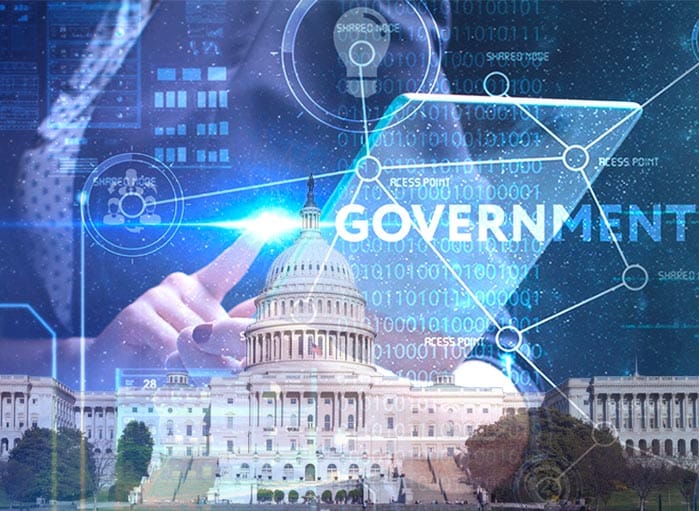
 Soumi Biswas
Soumi Biswas 
